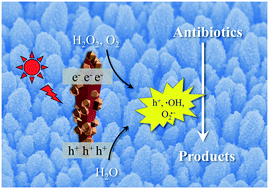当前位置:
X-MOL 学术
›
Catal. Sci. Technol.
›
论文详情
Our official English website, www.x-mol.net, welcomes your feedback! (Note: you will need to create a separate account there.)
Highly-oriented one-dimensional MOF-semiconductor nanoarrays for efficient photodegradation of antibiotics†
Catalysis Science & Technology ( IF 4.4 ) Pub Date : 2018-03-12 00:00:00 , DOI: 10.1039/c8cy00229k Xiang He 1, 2, 3, 4 , Vu Nguyen 1, 2, 3, 4 , Zhang Jiang 4, 5, 6, 7 , Dawei Wang 1, 2, 3, 4 , Zan Zhu 1, 2, 3, 4 , Wei-Ning Wang 1, 2, 3, 4
Catalysis Science & Technology ( IF 4.4 ) Pub Date : 2018-03-12 00:00:00 , DOI: 10.1039/c8cy00229k Xiang He 1, 2, 3, 4 , Vu Nguyen 1, 2, 3, 4 , Zhang Jiang 4, 5, 6, 7 , Dawei Wang 1, 2, 3, 4 , Zan Zhu 1, 2, 3, 4 , Wei-Ning Wang 1, 2, 3, 4
Affiliation

|
The ineffective removal of antibiotics from the aquatic environment has raised serious problems, including chronic toxicity and antibiotic resistance. Among the numerous strategies, photocatalytic degradation appears to be one of the promising methods to remove antibiotics. Semiconductors are the most widely used photocatalysts, whereas, their efficiencies still suffer from limited light absorption and poor charge separation. Given their exceptional properties, including a superior surface area and massive active sites, MOFs are excellent candidates for the formation of hierarchical nanostructures with semiconductors to address the above issues. In this study, highly-oriented one-dimensional (1D) MIL-100(Fe)/TiO2 nanoarrays were developed as photocatalysts for the first time (MIL = Materials Institute Lavoisier). The 1D structured TiO2 nanoarrays not only enable the direct and enhanced charge transport, but also permit easy recycling. With the in situ growth of MIL-100(Fe) on the TiO2 nanoarrays, the composite exhibits enhanced light absorption, electron/hole separation, and accessibility of active sites. As a result, up to 90.79% photodegradation efficiency of tetracycline, a representative antibiotic, by the MIL-100(Fe)/TiO2 composite nanoarrays was achieved, which is much higher than that of pristine TiO2 nanoarrays (35.22%). It is also worth mentioning that the composite nanoarrays demonstrate high stability and still exhibit high efficiency twice that of the pristine TiO2 nanoarrays even in the 5th run. This study offers a new strategy for the degradation of antibiotics by using 1D MOF-based nanocomposite nanoarrays.
中文翻译:

高度定向的一维MOF半导体纳米阵列,可有效降解抗生素†
从水生环境中不能有效地去除抗生素引起了严重的问题,包括慢性毒性和抗生素抗性。在众多策略中,光催化降解似乎是去除抗生素的有前途的方法之一。半导体是使用最广泛的光催化剂,然而,其效率仍然受到光吸收受限和电荷分离不良的困扰。鉴于其优异的性能(包括优越的表面积和大量的活性位点),MOFs是与半导体形成层级纳米结构以解决上述问题的极佳候选者。在这项研究中,高度定向的一维(1D)MIL-100(Fe)/ TiO 2纳米阵列首次被开发为光催化剂(MIL =材料研究所Lavoisier)。一维结构的TiO 2纳米阵列不仅能够直接和增强电荷传输,而且还易于回收。随着MIL-100(Fe)在TiO 2纳米阵列上的原位生长,该复合材料表现出增强的光吸收,电子/空穴分离以及活性位点的可及性。结果,MIL-100(Fe)/ TiO 2复合纳米阵列实现了代表性抗生素四环素的高达90.79%的光降解效率,远高于原始TiO 2纳米阵列(35.22%)。还值得一提的是,即使在第5次运行中,复合纳米阵列仍显示出高稳定性,并且仍具有原始TiO 2纳米阵列两倍的高效率。这项研究为使用基于一维MOF的纳米复合纳米阵列降解抗生素提供了新的策略。
更新日期:2018-03-12
中文翻译:

高度定向的一维MOF半导体纳米阵列,可有效降解抗生素†
从水生环境中不能有效地去除抗生素引起了严重的问题,包括慢性毒性和抗生素抗性。在众多策略中,光催化降解似乎是去除抗生素的有前途的方法之一。半导体是使用最广泛的光催化剂,然而,其效率仍然受到光吸收受限和电荷分离不良的困扰。鉴于其优异的性能(包括优越的表面积和大量的活性位点),MOFs是与半导体形成层级纳米结构以解决上述问题的极佳候选者。在这项研究中,高度定向的一维(1D)MIL-100(Fe)/ TiO 2纳米阵列首次被开发为光催化剂(MIL =材料研究所Lavoisier)。一维结构的TiO 2纳米阵列不仅能够直接和增强电荷传输,而且还易于回收。随着MIL-100(Fe)在TiO 2纳米阵列上的原位生长,该复合材料表现出增强的光吸收,电子/空穴分离以及活性位点的可及性。结果,MIL-100(Fe)/ TiO 2复合纳米阵列实现了代表性抗生素四环素的高达90.79%的光降解效率,远高于原始TiO 2纳米阵列(35.22%)。还值得一提的是,即使在第5次运行中,复合纳米阵列仍显示出高稳定性,并且仍具有原始TiO 2纳米阵列两倍的高效率。这项研究为使用基于一维MOF的纳米复合纳米阵列降解抗生素提供了新的策略。











































 京公网安备 11010802027423号
京公网安备 11010802027423号